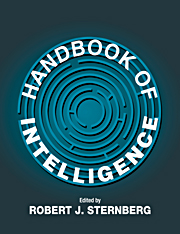Book contents
- Frontmatter
- Contents
- Preface
- Contributors
- PART I THE NATURE OF INTELLIGENCE AND ITS MEASUREMENT
- PART II DEVELOPMENT OF INTELLIGENCE
- 4 Heritability and Intelligence
- 5 Intellectual Development in Childhood
- 6 Intellectual Development in Adulthood
- PART III GROUP ANALYSES OF INTELLIGENCE
- PART IV BIOLOGY OF INTELLIGENCE
- PART V INTELLIGENCE AND INFORMATION PROCESSING
- PART VI KINDS OF INTELLIGENCE
- PART VII TESTING AND TEACHING INTELLIGENCE
- PART VIII INTELLIGENCE, SOCIETY, AND CULTURE
- PART IX INTELLIGENCE IN RELATION TO ALLIED CONSTRUCTS
- Author Index
- Subject Index
5 - Intellectual Development in Childhood
Published online by Cambridge University Press: 05 June 2012
- Frontmatter
- Contents
- Preface
- Contributors
- PART I THE NATURE OF INTELLIGENCE AND ITS MEASUREMENT
- PART II DEVELOPMENT OF INTELLIGENCE
- 4 Heritability and Intelligence
- 5 Intellectual Development in Childhood
- 6 Intellectual Development in Adulthood
- PART III GROUP ANALYSES OF INTELLIGENCE
- PART IV BIOLOGY OF INTELLIGENCE
- PART V INTELLIGENCE AND INFORMATION PROCESSING
- PART VI KINDS OF INTELLIGENCE
- PART VII TESTING AND TEACHING INTELLIGENCE
- PART VIII INTELLIGENCE, SOCIETY, AND CULTURE
- PART IX INTELLIGENCE IN RELATION TO ALLIED CONSTRUCTS
- Author Index
- Subject Index
Summary
Intellectual development is a vast topic – far too large even to begin to summarize in a single, relatively brief chapter. Therefore, this review is, of necessity, extremely selective. It includes two sections. The first briefly describes six theories of intellectual development, three longstanding ones and three more recent ones. The second focuses on a core area of intellectual development in which progress has been especially notable over the two decades since the previous edition of this handbook: the development of problem solving and learning.
THEORETICAL APPROACHES
Traditional Theories
psychometric approaches. Psychometric theories are aimed at explaining individual and developmental differences in performance on standardized tests of intellectual performance – especially IQ tests. Underlying such theories is the assumption that intelligence can be assessed in terms of latent sources of individual differences or “factors.” Psychometric theories can be divided by the number of factors that they emphasize: one, a few, or many. Consider a prominent example of each. Spearman (1927) emphasized that underlying all intellectual performance is a single common general factor (g). Thurstone (1938) proposed that intelligence involves seven primary mental abilities: verbal comprehension, verbal fluency, number, spatial visualization, memory, reasoning, and perceptual speed. Guilford (1967) hypothesized the existence of 180 ability factors based on the possible combinations of three dimensions that were present in all tasks: content, operation, and product. The one-few-many trichotomy also applies to nonpsychometric theories of intellectual development.
- Type
- Chapter
- Information
- Handbook of Intelligence , pp. 92 - 116Publisher: Cambridge University PressPrint publication year: 2000
- 11
- Cited by



